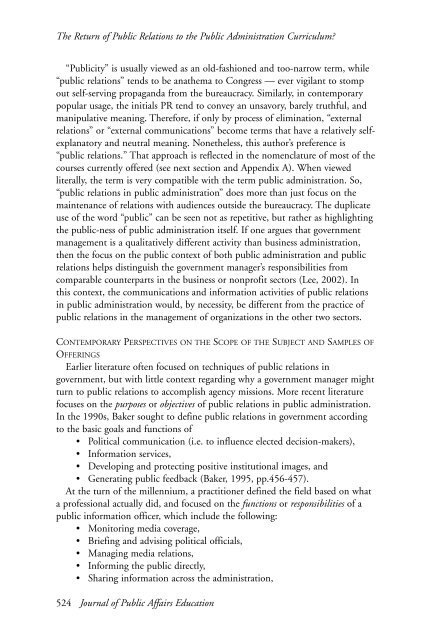JOURNAL OF PUBLIC AFFAIRS EDUCATION - National ...
JOURNAL OF PUBLIC AFFAIRS EDUCATION - National ...
JOURNAL OF PUBLIC AFFAIRS EDUCATION - National ...
Create successful ePaper yourself
Turn your PDF publications into a flip-book with our unique Google optimized e-Paper software.
The Return of Public Relations to the Public Administration Curriculum?<br />
“Publicity” is usually viewed as an old-fashioned and too-narrow term, while<br />
“public relations” tends to be anathema to Congress — ever vigilant to stomp<br />
out self-serving propaganda from the bureaucracy. Similarly, in contemporary<br />
popular usage, the initials PR tend to convey an unsavory, barely truthful, and<br />
manipulative meaning. Therefore, if only by process of elimination, “external<br />
relations” or “external communications” become terms that have a relatively selfexplanatory<br />
and neutral meaning. Nonetheless, this author’s preference is<br />
“public relations.” That approach is reflected in the nomenclature of most of the<br />
courses currently offered (see next section and Appendix A). When viewed<br />
literally, the term is very compatible with the term public administration. So,<br />
“public relations in public administration” does more than just focus on the<br />
maintenance of relations with audiences outside the bureaucracy. The duplicate<br />
use of the word “public” can be seen not as repetitive, but rather as highlighting<br />
the public-ness of public administration itself. If one argues that government<br />
management is a qualitatively different activity than business administration,<br />
then the focus on the public context of both public administration and public<br />
relations helps distinguish the government manager’s responsibilities from<br />
comparable counterparts in the business or nonprofit sectors (Lee, 2002). In<br />
this context, the communications and information activities of public relations<br />
in public administration would, by necessity, be different from the practice of<br />
public relations in the management of organizations in the other two sectors.<br />
CONTEMPORARY PERSPECTIVES ON THE SCOPE <strong>OF</strong> THE SUBJECT AND SAMPLES <strong>OF</strong><br />
<strong>OF</strong>FERINGS<br />
Earlier literature often focused on techniques of public relations in<br />
government, but with little context regarding why a government manager might<br />
turn to public relations to accomplish agency missions. More recent literature<br />
focuses on the purposes or objectives of public relations in public administration.<br />
In the 1990s, Baker sought to define public relations in government according<br />
to the basic goals and functions of<br />
• Political communication (i.e. to influence elected decision-makers),<br />
• Information services,<br />
• Developing and protecting positive institutional images, and<br />
• Generating public feedback (Baker, 1995, pp.456-457).<br />
At the turn of the millennium, a practitioner defined the field based on what<br />
a professional actually did, and focused on the functions or responsibilities of a<br />
public information officer, which include the following:<br />
• Monitoring media coverage,<br />
• Briefing and advising political officials,<br />
• Managing media relations,<br />
• Informing the public directly,<br />
• Sharing information across the administration,<br />
524 Journal of Public Affairs Education

















